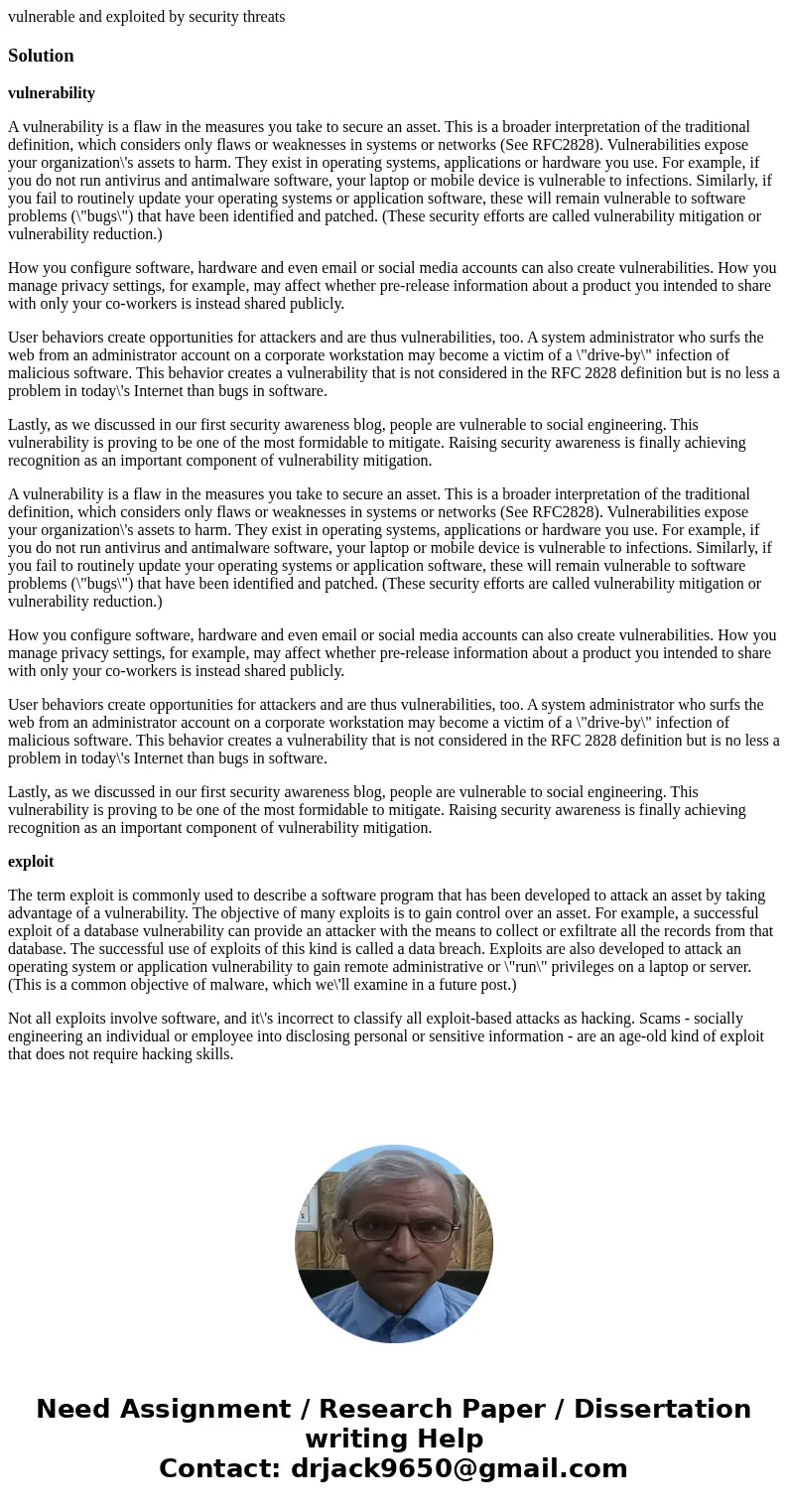vulnerable and exploited by security threatsSolutionvulnerab
vulnerable and exploited by security threats
Solution
vulnerability
A vulnerability is a flaw in the measures you take to secure an asset. This is a broader interpretation of the traditional definition, which considers only flaws or weaknesses in systems or networks (See RFC2828). Vulnerabilities expose your organization\'s assets to harm. They exist in operating systems, applications or hardware you use. For example, if you do not run antivirus and antimalware software, your laptop or mobile device is vulnerable to infections. Similarly, if you fail to routinely update your operating systems or application software, these will remain vulnerable to software problems (\"bugs\") that have been identified and patched. (These security efforts are called vulnerability mitigation or vulnerability reduction.)
How you configure software, hardware and even email or social media accounts can also create vulnerabilities. How you manage privacy settings, for example, may affect whether pre-release information about a product you intended to share with only your co-workers is instead shared publicly.
User behaviors create opportunities for attackers and are thus vulnerabilities, too. A system administrator who surfs the web from an administrator account on a corporate workstation may become a victim of a \"drive-by\" infection of malicious software. This behavior creates a vulnerability that is not considered in the RFC 2828 definition but is no less a problem in today\'s Internet than bugs in software.
Lastly, as we discussed in our first security awareness blog, people are vulnerable to social engineering. This vulnerability is proving to be one of the most formidable to mitigate. Raising security awareness is finally achieving recognition as an important component of vulnerability mitigation.
A vulnerability is a flaw in the measures you take to secure an asset. This is a broader interpretation of the traditional definition, which considers only flaws or weaknesses in systems or networks (See RFC2828). Vulnerabilities expose your organization\'s assets to harm. They exist in operating systems, applications or hardware you use. For example, if you do not run antivirus and antimalware software, your laptop or mobile device is vulnerable to infections. Similarly, if you fail to routinely update your operating systems or application software, these will remain vulnerable to software problems (\"bugs\") that have been identified and patched. (These security efforts are called vulnerability mitigation or vulnerability reduction.)
How you configure software, hardware and even email or social media accounts can also create vulnerabilities. How you manage privacy settings, for example, may affect whether pre-release information about a product you intended to share with only your co-workers is instead shared publicly.
User behaviors create opportunities for attackers and are thus vulnerabilities, too. A system administrator who surfs the web from an administrator account on a corporate workstation may become a victim of a \"drive-by\" infection of malicious software. This behavior creates a vulnerability that is not considered in the RFC 2828 definition but is no less a problem in today\'s Internet than bugs in software.
Lastly, as we discussed in our first security awareness blog, people are vulnerable to social engineering. This vulnerability is proving to be one of the most formidable to mitigate. Raising security awareness is finally achieving recognition as an important component of vulnerability mitigation.
exploit
The term exploit is commonly used to describe a software program that has been developed to attack an asset by taking advantage of a vulnerability. The objective of many exploits is to gain control over an asset. For example, a successful exploit of a database vulnerability can provide an attacker with the means to collect or exfiltrate all the records from that database. The successful use of exploits of this kind is called a data breach. Exploits are also developed to attack an operating system or application vulnerability to gain remote administrative or \"run\" privileges on a laptop or server. (This is a common objective of malware, which we\'ll examine in a future post.)
Not all exploits involve software, and it\'s incorrect to classify all exploit-based attacks as hacking. Scams - socially engineering an individual or employee into disclosing personal or sensitive information - are an age-old kind of exploit that does not require hacking skills.

 Homework Sourse
Homework Sourse